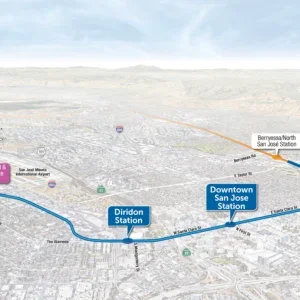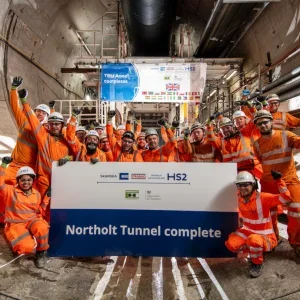Following months of box station excavation and completion of the first section of sprayed concrete lining tunnel, work on the new Line 4 being built for the Budapest metro has moved on to the TBM drives.
At the beginning of this month JV tunnel contractor Bamco launched a 6.05m diameter Herrenknecht TBM near Kelenfolfi station at the west end of the line to drive 5.35km of the one of the 7.2km long running tunnels. The second, sister EPBM (total thrust 29,270kN, cutterhead power 1200kW) on the twin tube drives was scheduled to begin a similar run before the end of April.
Vinci leads JV contractor Bamco, which also includes Strabag – the Austria firm as well as the local arm – and Hungarian firm Hidepito. The contract to build the tunnels, including design and Szent Gellertter station on the west bank of the river Danube, is worth US$243M (late 2005 prices). The TBM contract is worth about 10% of the Euro-valued contract.
Geology along the running tunnel alignment passes from competent marls on the west side of the Danube to sands, silts and gravels on the east side. There are faults through the strata on both sides of the river (T&TI, August 2005, p7).
Tunnel boring was originally scheduled to begin in January and take 84 weeks. The current schedule anticipates the TBM drives reaching the end of the first section of the line by May 2009. The service is scheduled to come into operation over the first part of the line, from Kelenfoldi to Keleti, at the beginning of 2010. A year later the full line should be in operation, reaching Bosnyak – about 35 years after design work began.
The Line 4 project was revived to build a fast link across the city, connecting two main rail stations – Kelenfoldi on the west, Buda, side of the river and Keleti on the east, Pest, side – and tie-in another metro line, Line 3, at Kalvin also in the east. Starting at Kelenfoldi, the route of the line crosses the Danube to where the majority of the stations will be built, and it will end at Bosnyak.
The first stage of the project includes 10 stations with extensive use of box and SCL excavations. Tunnelling works started last year on the Buda side, and works on the Pest side are getting underway. The reality of the extensive needs in the city for the massive construction project is beginning to bite as major roads start to be closed and traffic diverted. Challenges include Fovam station, on the east bank, as the platforms extend under the river and the excavations will also be near old buildings and the Erzsebet, or ‘Elizabeth’, bridge.
Tunnelling works have seen the completion of a 74m long SCL bore at Bocskai station, on the Buda side, for the running tunnel and a ventilation duct. The tunnel was driven through stiff Kiscalli clay at an average of 2m per day working to a top heading and invert sequence. The 9.1m wide by 7.6m high section has around 10m cover, primary lining of dry mix shotcrete and cast insitu concrete secondary lining. Contractor Swietelsky-Obayashi completed the work in February.
Designers for contractor Bamco are Fomterv-Uvatrev with Mott MacDonald inputting specialist tunnelling advice. The client is BKV, delivering via its DBR team, and consultant Eurometro.







